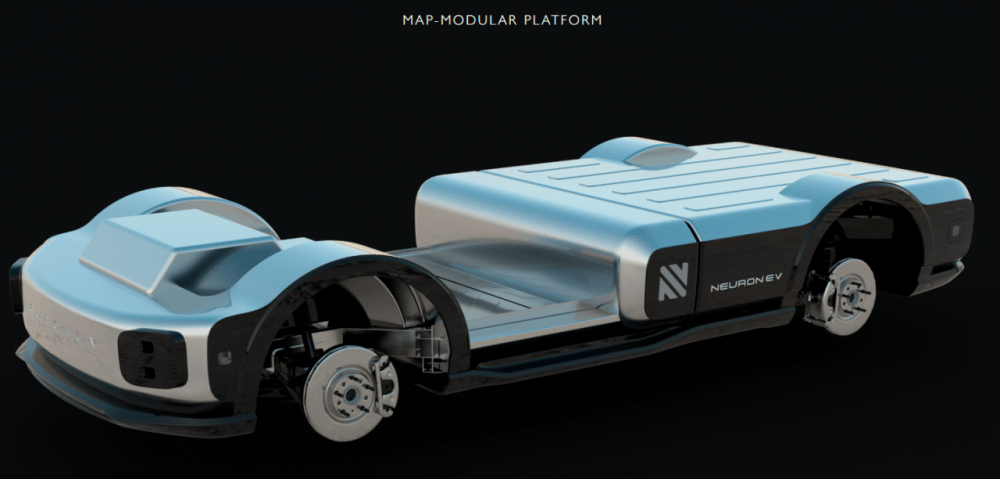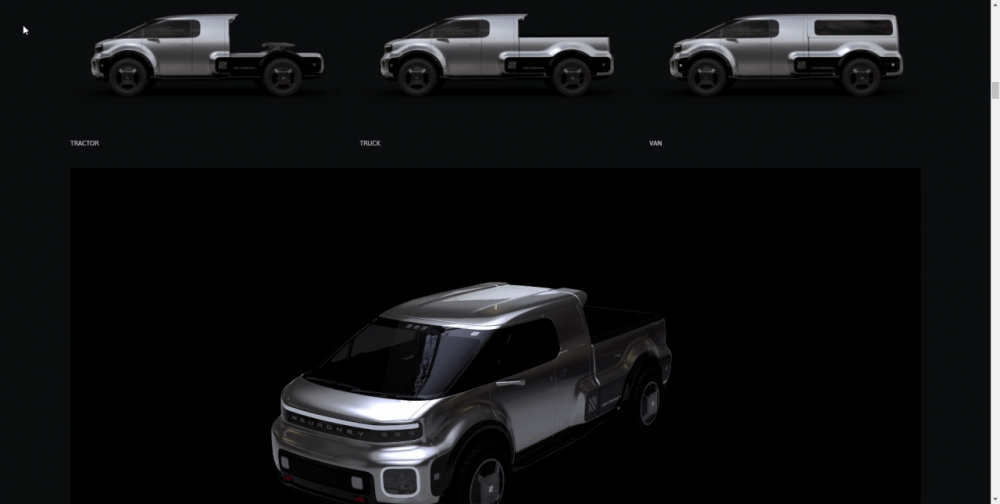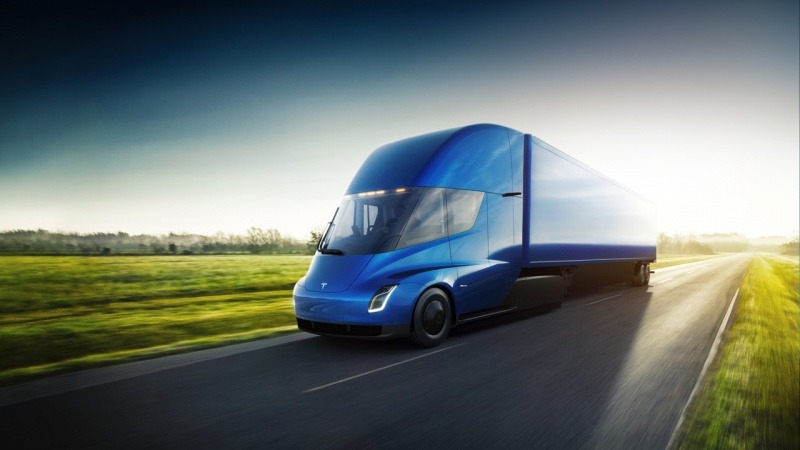Search the Community
Showing results for tags 'semi truck'.
-
NEURON EV CES 2020 has been a busy place this year with more auto companies showing of prototypes and finally production ready auto's than ever before. We have seen so much including the latest in super dense solid state batteries for the EVs to motorcycles and bikes. This year we now get to see the latest competition to Tesla and Rivian in a well funded California / China based EV auto company called NEURON EV. This company has a swiss army knife of a truck/suv auto as well as a Semi truck that they say is going into production in 2020. The truck which is seen here in Silver has a sister truck that was running around the streets which is the following Black T-One. All the details you could ever want can be found here on this truck: https://www.neuronev.co/new-products/t-one-p-gyrwr The cool thing about this modular truck is that is can be more than a truck, a tractor, a van. there are no limits to how one can configure up this beast of an EV. The seat options are an interesting take as you can go like how Tesla showed their Semi with a center driving position as a base 3 seat configuration of 3 captain chairs, or a single drivers captain chair and a bench seat behind for 4 people and go from there to cover a wide range of colors, materials, etc. in customizing your auto. While this company is looking at this modular truck and semi for the US, in china they will have many more auto options including their V.E.G.A. or Versatile Electric Grand Automobile. The company has great plans and while they have only two models for the US market, China will get many more that includes a medium duty truck, a bus, a MAP or Multipurpose Autonomous Platform focused on shipping yards, a HUB or autonomous transportation auto, in addition to the car, semi and truck. NEURON EV has not released any details about their hp / torque other than to say class leading at this time. Two wheel drive and All Wheel Drive will be the choices folks will have and talk of a base 300 mile range battery pack. More details are to come later this year. First Press release of 2020 can be found here: https://www.neuronev.co/01102020 https://www.youtube.com/channel/UC69MUFfq-4W8qxUWcGltBUg
- 59 replies
-
- ev
- semi truck
-
(and 1 more)
Tagged with:
-
We never thought that we would ever see the day that a semi truck would get as much hype as an upcoming sports car or one of Tesla's new models. But that's the case with Tesla's new semi truck that debut last night. The design reminds us of GM's original 'dustbuster' vans with a clean shape and wide glass area. Tesla says the overall drag coefficient of their semi is 0.36, making it more aerodynamic than a Bugatti Chiron. The interior follows the look of the Model 3 with a minimalistic design and large screens providing key information and controls for various functions. The driver is positioned in the middle to provide a commanding view of the road. Under the semi's skin, Tesla employs the same chassis design as their passenger vehicles with the batteries sitting low in the chassis to improve the center of gravity. Power comes from four electric motors from the Model 3 for the rear wheels. Tesla isn't saying how much power the motors produce, but went into full detail about performance. 0-60 mph in 5 seconds when towing an unladen trailer (How many fleet operators care about this? -WM) When at its max gross weight of 80,000 pounds, the truck can hit 60 mph in 20 seconds Traveling up a 5 percent incline, the Tesla semi can up to 65 mph, 20 mph more than a standard diesel semi Maximum range of 500 miles Tesla is planning to have a network of "Megachargers," DC charging stations along common routes, and the origin and destination points. The chargers can provide a 400 mile range within 30 minutes. For safety, all Tesla Semi trucks will come with an enhanced version of Autopilot, cameras around the vehicle to provide a surround view, a jackknife prevention system that uses sensors to detect instability and adjust the power of each electric motor, lane keep assist, and automatic emergency braking. Tesla is also touting the low operating costs of their new semi. Per mile, the Tesla semi is said to cost $1.26, while rival diesel trucks cost $1.56 per mile. This is due to Tesla's semi having less moving parts than a standard semi truck and lower fuel costs. We're wondering how Tesla came to this number. Production is expected to begin in 2019 and if you're interested, you can place a $5,000 deposit. Time to address the elephants in the room. Tesla hasn't said where they plan on building their new semi truck as Freemont will be at its capacity if the company reaches their passenger car production goals. Then there are production issues with the Model 3 which has caused the automaker to push back their production ramp-up to next year. That's not including Tesla's track record of missing production dates. They're also burning through cash at a very alarming rate to work various issues. We haven't even gotten to talking about the 'Megachargers' which needs to be built out. How Tesla plans to achieve these goals remains to be seen. Source: Tesla Press Release is on Page 2 Tesla Semi The Tesla Semi will deliver a far better experience for truck drivers, while increasing safety and significantly reducing the cost of cargo transport. Unrivaled Performance Without a trailer, the Tesla Semi achieves 0-60 mph in five seconds, compared to 15 seconds in a comparable diesel truck. It does 0-60 mph in 20 seconds with a full 80,000-pound load, a task that takes a diesel truck about a minute. Most notably for truck drivers and other travelers on the road, it climbs 5% grades at a steady 65 mph, whereas a diesel truck maxes out at 45 mph on a 5% grade. The Tesla Semi requires no shifting or clutching for smooth acceleration and deceleration, and its regenerative braking recovers 98% of kinetic energy to the battery, giving it a basically infinite brake life. Overall, the Semi is more responsive, covers more miles than a diesel truck in the same amount of time, and more safely integrates with passenger car traffic. Driver Experience Unlike other trucks, the Semi’s cabin is designed specifically around the driver, featuring unobstructed stairs for easier entry and exit, full standing room inside, and a centered driver position for optimal visibility. Two touchscreen displays positioned symmetrically on both sides of the driver provide easy access to navigation, blind spot monitoring and electronic data logging. Built-in connectivity integrates directly with a fleet’s management system to support routing and scheduling, and remote monitoring. Diesel trucks today currently require several third party devices for similar functionality. Megachargers, a new high-speed DC charging solution, will add about 400 miles in 30 minutes and can be installed at origin or destination points and along heavily trafficked routes, enabling recharging during loading, unloading, and driver breaks. Safety The Tesla Semi’s all-electric architecture is designed to have a higher safety standard than any other heavy-duty truck on the market, with a reinforced battery that shields the Semi from impact and gives it an exceptionally low center of gravity. Its windshield is made of impact resistant glass. Jackknifing is prevented due to the Semi's onboard sensors that detect instability and react with positive or negative torque to each wheel while independently actuating all brakes. The surround cameras aid object detection and minimize blind spots, automatically alerting the driver to safety hazards and obstacles. With Enhanced Autopilot, the Tesla Semi features Automatic Emergency Braking, Automatic Lane Keeping, Lane Departure Warning, and event recording. Tesla Semi can also travel in a convoy, where one or several Semi trucks will be able to autonomously follow a lead Semi. Reliability With far fewer moving parts than a diesel truck – no engine, transmission, after-treatment system or differentials to upkeep – the Tesla Semi requires significantly less maintenance. Its battery is similar in composition to the batteries of Tesla energy products and is designed to support repeated charging cycles for over a million miles, while its motors are derived from the motors used in Model 3 and have been validated to last more than one million miles under the most demanding conditions. Lowest Cost of Ownership All-in, the Tesla Semi delivers massive savings in energy costs, performance, efficiency and reliability. TThe biggest immediate cost-advantage comes from savings in energy costs: fully loaded, the Tesla Semi consumes less than two kilowatt-hours of energy per mile and is capable of 500 miles of range at GVW and highway speed, accommodating a wide range of shipping applications given that nearly 80% of freight in the U.S. is moved less than 250 miles. Coupled with the low and stable nature of electricity prices – which average $0.12/kWh in the U.S. and can be significantly less for commercial and industrial users, falling to almost nothing when combined with local solar generation and storage – owners can expect to gain $200,000 or more in savings over a million miles based on fuel costs alone. Reservations for the Tesla Semi can be made for $5,000 USD per truck. Production in 2019.
- 23 comments
-
- 1
-

-
- electric semi truck
- reveal
-
(and 2 more)
Tagged with:
-
We never thought that we would ever see the day that a semi truck would get as much hype as an upcoming sports car or one of Tesla's new models. But that's the case with Tesla's new semi truck that debut last night. The design reminds us of GM's original 'dustbuster' vans with a clean shape and wide glass area. Tesla says the overall drag coefficient of their semi is 0.36, making it more aerodynamic than a Bugatti Chiron. The interior follows the look of the Model 3 with a minimalistic design and large screens providing key information and controls for various functions. The driver is positioned in the middle to provide a commanding view of the road. Under the semi's skin, Tesla employs the same chassis design as their passenger vehicles with the batteries sitting low in the chassis to improve the center of gravity. Power comes from four electric motors from the Model 3 for the rear wheels. Tesla isn't saying how much power the motors produce, but went into full detail about performance. 0-60 mph in 5 seconds when towing an unladen trailer (How many fleet operators care about this? -WM) When at its max gross weight of 80,000 pounds, the truck can hit 60 mph in 20 seconds Traveling up a 5 percent incline, the Tesla semi can up to 65 mph, 20 mph more than a standard diesel semi Maximum range of 500 miles Tesla is planning to have a network of "Megachargers," DC charging stations along common routes, and the origin and destination points. The chargers can provide a 400 mile range within 30 minutes. For safety, all Tesla Semi trucks will come with an enhanced version of Autopilot, cameras around the vehicle to provide a surround view, a jackknife prevention system that uses sensors to detect instability and adjust the power of each electric motor, lane keep assist, and automatic emergency braking. Tesla is also touting the low operating costs of their new semi. Per mile, the Tesla semi is said to cost $1.26, while rival diesel trucks cost $1.56 per mile. This is due to Tesla's semi having less moving parts than a standard semi truck and lower fuel costs. We're wondering how Tesla came to this number. Production is expected to begin in 2019 and if you're interested, you can place a $5,000 deposit. Time to address the elephants in the room. Tesla hasn't said where they plan on building their new semi truck as Freemont will be at its capacity if the company reaches their passenger car production goals. Then there are production issues with the Model 3 which has caused the automaker to push back their production ramp-up to next year. That's not including Tesla's track record of missing production dates. They're also burning through cash at a very alarming rate to work various issues. We haven't even gotten to talking about the 'Megachargers' which needs to be built out. How Tesla plans to achieve these goals remains to be seen. Source: Tesla Press Release is on Page 2 Tesla Semi The Tesla Semi will deliver a far better experience for truck drivers, while increasing safety and significantly reducing the cost of cargo transport. Unrivaled Performance Without a trailer, the Tesla Semi achieves 0-60 mph in five seconds, compared to 15 seconds in a comparable diesel truck. It does 0-60 mph in 20 seconds with a full 80,000-pound load, a task that takes a diesel truck about a minute. Most notably for truck drivers and other travelers on the road, it climbs 5% grades at a steady 65 mph, whereas a diesel truck maxes out at 45 mph on a 5% grade. The Tesla Semi requires no shifting or clutching for smooth acceleration and deceleration, and its regenerative braking recovers 98% of kinetic energy to the battery, giving it a basically infinite brake life. Overall, the Semi is more responsive, covers more miles than a diesel truck in the same amount of time, and more safely integrates with passenger car traffic. Driver Experience Unlike other trucks, the Semi’s cabin is designed specifically around the driver, featuring unobstructed stairs for easier entry and exit, full standing room inside, and a centered driver position for optimal visibility. Two touchscreen displays positioned symmetrically on both sides of the driver provide easy access to navigation, blind spot monitoring and electronic data logging. Built-in connectivity integrates directly with a fleet’s management system to support routing and scheduling, and remote monitoring. Diesel trucks today currently require several third party devices for similar functionality. Megachargers, a new high-speed DC charging solution, will add about 400 miles in 30 minutes and can be installed at origin or destination points and along heavily trafficked routes, enabling recharging during loading, unloading, and driver breaks. Safety The Tesla Semi’s all-electric architecture is designed to have a higher safety standard than any other heavy-duty truck on the market, with a reinforced battery that shields the Semi from impact and gives it an exceptionally low center of gravity. Its windshield is made of impact resistant glass. Jackknifing is prevented due to the Semi's onboard sensors that detect instability and react with positive or negative torque to each wheel while independently actuating all brakes. The surround cameras aid object detection and minimize blind spots, automatically alerting the driver to safety hazards and obstacles. With Enhanced Autopilot, the Tesla Semi features Automatic Emergency Braking, Automatic Lane Keeping, Lane Departure Warning, and event recording. Tesla Semi can also travel in a convoy, where one or several Semi trucks will be able to autonomously follow a lead Semi. Reliability With far fewer moving parts than a diesel truck – no engine, transmission, after-treatment system or differentials to upkeep – the Tesla Semi requires significantly less maintenance. Its battery is similar in composition to the batteries of Tesla energy products and is designed to support repeated charging cycles for over a million miles, while its motors are derived from the motors used in Model 3 and have been validated to last more than one million miles under the most demanding conditions. Lowest Cost of Ownership All-in, the Tesla Semi delivers massive savings in energy costs, performance, efficiency and reliability. TThe biggest immediate cost-advantage comes from savings in energy costs: fully loaded, the Tesla Semi consumes less than two kilowatt-hours of energy per mile and is capable of 500 miles of range at GVW and highway speed, accommodating a wide range of shipping applications given that nearly 80% of freight in the U.S. is moved less than 250 miles. Coupled with the low and stable nature of electricity prices – which average $0.12/kWh in the U.S. and can be significantly less for commercial and industrial users, falling to almost nothing when combined with local solar generation and storage – owners can expect to gain $200,000 or more in savings over a million miles based on fuel costs alone. Reservations for the Tesla Semi can be made for $5,000 USD per truck. Production in 2019. View full article
- 23 replies
-
- 2
-

-

-
- electric semi truck
- reveal
-
(and 2 more)
Tagged with:








